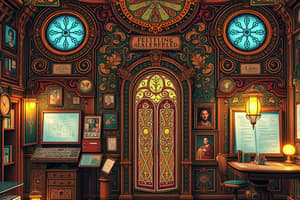Podcast
Questions and Answers
What is a primary goal of electrical systems design in buildings?
What is a primary goal of electrical systems design in buildings?
- To ensure safety and prevent hazards (correct)
- To minimize the installation cost
- To increase the overall building height
- To maximize the number of electrical outlets
Which of the following is NOT a key principle in electrical systems design?
Which of the following is NOT a key principle in electrical systems design?
- Efficiency
- Compliance with Codes and Standards
- Safety
- Aesthetics (correct)
What is meant by voltage in electrical systems?
What is meant by voltage in electrical systems?
- The electric potential difference (correct)
- The opposition to current flow
- The flow of electric charge
- The total power consumption of an appliance
Why is ensuring reliability important in electrical systems design?
Why is ensuring reliability important in electrical systems design?
What does resistance in electrical systems represent?
What does resistance in electrical systems represent?
What is the primary role of a service entrance in an electrical system?
What is the primary role of a service entrance in an electrical system?
Which electrical code governs installations and safety regulations in the United States?
Which electrical code governs installations and safety regulations in the United States?
What is the primary purpose of protective devices in electrical systems?
What is the primary purpose of protective devices in electrical systems?
What should be assessed during the needs assessment phase of electrical design?
What should be assessed during the needs assessment phase of electrical design?
Which component is responsible for central power distribution and circuit protection?
Which component is responsible for central power distribution and circuit protection?
What type of current is primarily used in residential and commercial buildings?
What type of current is primarily used in residential and commercial buildings?
Which aspect is NOT included in the electrical system requirements for commercial buildings?
Which aspect is NOT included in the electrical system requirements for commercial buildings?
What is the purpose of load estimation in electrical design?
What is the purpose of load estimation in electrical design?
Which of the following is NOT a type of electrical outlet mentioned?
Which of the following is NOT a type of electrical outlet mentioned?
Which organization provides global standards for electrical installations?
Which organization provides global standards for electrical installations?
Flashcards
Electrical Safety
Electrical Safety
Using systems and practices to prevent electrical fires and shocks.
Voltage (V)
Voltage (V)
Electric potential difference, measured in volts.
Current (I)
Current (I)
Flow of electric charge, measured in amperes.
Resistance (R)
Resistance (R)
Signup and view all the flashcards
AC (Alternating Current)
AC (Alternating Current)
Signup and view all the flashcards
DC (Direct Current)
DC (Direct Current)
Signup and view all the flashcards
Load Estimation
Load Estimation
Signup and view all the flashcards
System Planning
System Planning
Signup and view all the flashcards
Component Selection
Component Selection
Signup and view all the flashcards
Electrical Codes
Electrical Codes
Signup and view all the flashcards
Service Entrance
Service Entrance
Signup and view all the flashcards
Distribution Board
Distribution Board
Signup and view all the flashcards
Protective Devices
Protective Devices
Signup and view all the flashcards
Building Electric Service
Building Electric Service
Signup and view all the flashcards
Power Distribution
Power Distribution
Signup and view all the flashcards
Study Notes
Importance of Electrical Systems Design
- Safety: Prevents electrical fires and shocks.
- Efficiency: Minimizes energy loss and optimizes performance.
- Reliability: Ensures continuous operation and handles expected loads.
- Compliance with Codes and Standards: Adheres to national and local regulations for safety and legality.
Fundamental Concepts
- Voltage (V): Electric potential difference.
- Current (I): Flow of electric charge.
- Resistance (R): Opposition to current flow.
- AC (Alternating Current): Common in buildings.
- DC (Direct Current): Used in specific applications.
- Power (Watts): Rate of energy consumption.
- Energy (kWh): Total consumption over time.
Electrical Design Process Overview
- Needs Assessment: Determine electrical requirements based on building usage.
- Load Estimation: Calculate expected electrical load to ensure system capacity.
- System Planning: Layout design and component specification.
- Component Selection: Choose appropriate wires, breakers, and other components for compatibility and safety.
- Installation and Testing: Proper installation techniques and thorough testing for functionality.
Electrical Codes and Standards
- Philippine Electrical Code (PEC): Comprehensive guidelines and regulations for electrical installations in the Philippines.
- National Electrical Code (NEC): Key regulations in the US for safety and installation standards.
- International Electrotechnical Commission (IEC): Global standards for international compliance.
Components of Electrical Systems
- Service Entrance: Entry point for power, includes the main disconnect switch.
- Panels and Distribution Boards: Central power distribution, consists of breakers and circuit protection.
- Conductors and Cables: Pathways for electricity, available in various types and ratings.
- Protective Devices (Circuit Breakers, Fuses): Overcurrent protection to prevent electrical faults.
- Lighting and Power Outlets: End-use points, available in various types of fixtures and outlets.
Electrical System Requirements
- Building Electric Service (Service Entrance): Includes incoming utility service coordination, utility company metering, substation and main equipment layout.
- Power Distribution System: Includes normal power distribution, emergency/standby power distribution, uninterruptible power supply (UPS) distribution, and redundant power supply distribution.
- Lighting: Includes interior and exterior lighting, utilitarian and decorative lighting, task and general lighting.
- Power for Electrical Equipment: Includes transportation systems (elevators, escalators, walkalators, dumbwaiters), space conditioning (heating, ventilation, air conditioning), plumbing (hot and cold water systems, water treatment, sewage treatment, fountains, water features, swimming pools), fire protection (fire and jockey pumps, sprinkler system), communications (voice and data, MATV, public address, paging system, intercom, nurses' call system).
- Grounding and Bonding: Includes air-terminals and lightning protection system, electrical system grounding.
Studying That Suits You
Use AI to generate personalized quizzes and flashcards to suit your learning preferences.




